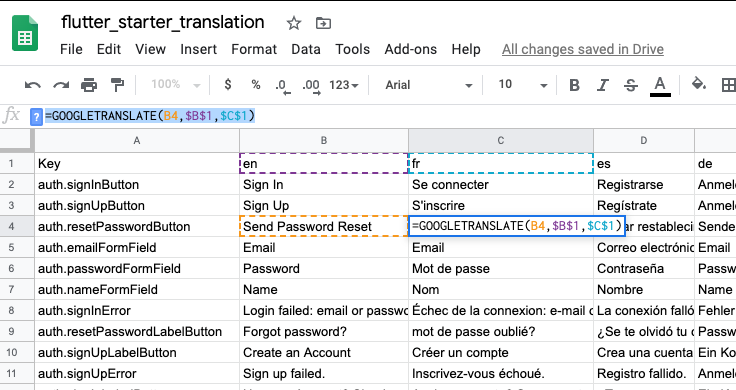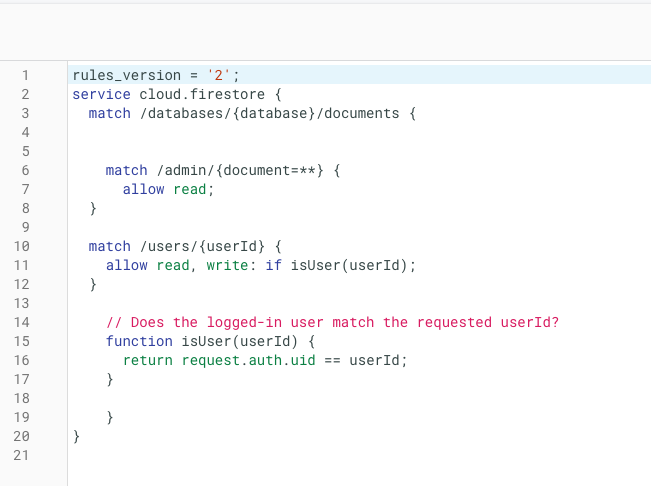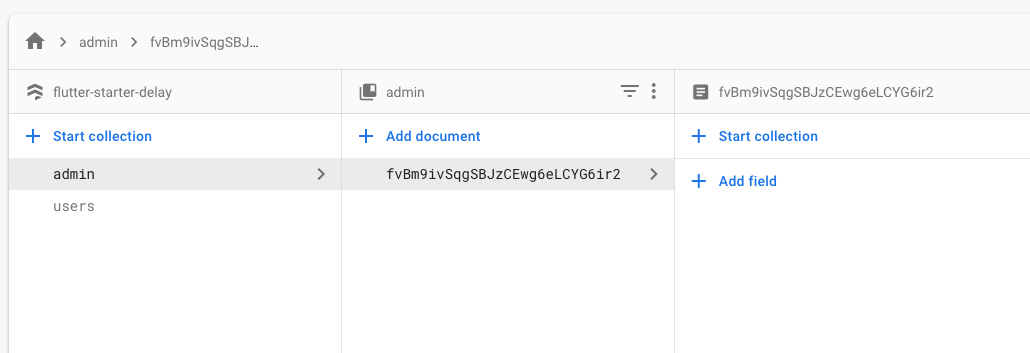GetX simplify & optimise a lot how to use Flutter!
You should read a bit about GetX and Firebase.
That project is link by default to a personal firebase to make you able to test the project easily without changing anything for a first view!
- Firebase (firebase_core, firebase_auth, cloud_firestore)
- GetX
- get_storage
- crypto
- http
- csv (Use to convert csv of google excel translations)
flutter pub getwill install required packagesflutter runwill run the app on a device. (It will ask which devices if you got few)flutter deviceswill show you your devices list.flutter run -d {device}will run on the chosen device.flutter build {web | ios | android}will build the app for the chosen platform.flutter run --releasewill let you test an optimized build (Like the release).
A2 in the Main (All merge) tab contain the formula that merges tabs together.
You can run a command line app to generate the GetX Localization class which pulls from a google sheet
- Go to
lib/helpersfolder - Run
dart update_localizations.dart
P.S. If you copy the translation to create your own, be sure to share the excel to everyone who possess the link to make the script able to get translations.
It's currently link to a test one on mine (To make your test rapidly of that Repo #imSoNice) but if make sure you setup firebase with your project to continue your development.
There should be things to replace: (When you will setup your proper firebase)
- A file for IOS (
/ios/Runner/GoogleService-Info.plist) - A file for Android (
/android/app/google-services.json) - Credentials to replace for web. (In
/web/index.html)
The rules in Firestore for this project are fairly simple. Here are the rules -created.
-
The first rule matches any user in the admin collection and allows you to read that document only. No one is allowed to write to this collection. I manually add my admin users through the firebase console.
-
The second rule allows the user to read and write only if the user matches the currently logged in user. So a user can only change information about themselves. Here is how my collections are setup in Firestore.
Use as far as you can the themes.
TODO: There is more to add here
main.dart — contains info for maintaining the state of the app for the theme, language and user. It initializes language and theme settings. Sets up routing.
Tips: Try to use & edit app_themes constants as more as you can.
app_themes.dart — contains info related to our light and dark themes.
globals.dart — contains some global app settings
app_routes.dart — contains the app routes.
Tips: The controllers are contains a lot of logic and think it a way to be reusable!
auth_controller.dart — our user and authentication functions for creating, logging in and out our user and saving our user data.
language_controller.dart — saves and loads our selected language.
theme_controller.dart — saves and loads our selected theme.
Tips: The google excel way is so nice. Use that update_localizations script!
validator.dart — contains some validation functions for our form fields.
update_localizations.dart — command line dart app that generates the localization.g.dart file.
localizations.g.dart — this file is generated from our google sheet (do not manually edit this file).
user_model.dart — contains the model for our user saved in Firestore.
menu_option_model.dart — contains our model for our language options and theme options in settings.
Tips:
- Screens should use components and add max-width, margin & spacing between them.
- The screens file name should has similar name if not a exact name as the url & className should be like
NameScreen.
home.dart — contains the ui for the home which shows info about the user.
settings.dart — contains the settings screen for setting the theme and language and some user settings.
splash.dart — contains the initial loading screen, currently just a circular progress indicator.
Tips: If there is a lot of screen that share a common purpose, group them in a folder.
reset-password.dart — sends a password reset email to the user.
sign-in.dart — allows user to login with email and password.
sign-up.dart — allows user to create a new account.
update-profile.dart — allows user to change his email or name.
Tips: The components should NOT have a max-width, margin/padding most of the time! I mean except for the components with that purpose like the Section.
section.dart — Add a padding(left/right) and max-width for a section. Imagine (Layout -> Section -> Content/Components)
avatar.dart — displays a user avatar on the home.
dropdown_picker.dart — shows a dropdown list.
dropdown_picker_with_icon.dart — shows a dropdown list with icons.
form_input_field.dart — handles our form field elements.
form_input_field_with_icon.dart — handles our form field elements but has an icon too.
vertical_spacing.dart — just a space in the ui.
label_button.dart — one type of button in ui.
loading.dart — circular loading indicator overlay.
logo_graphic_header.dart — a graphic displayed in our ui.
primary_button.dart — another button in the ui.
segmented_selector.dart — a control used to select the theme.


